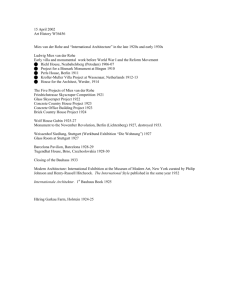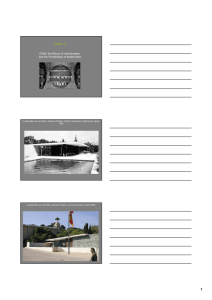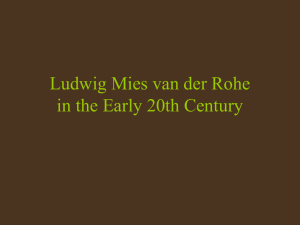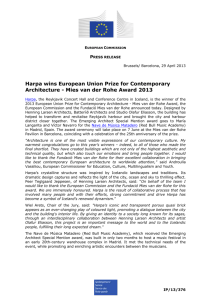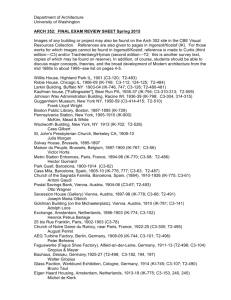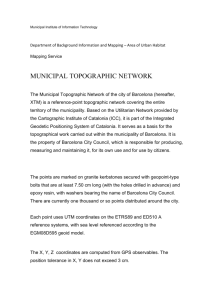75th ANNIVERSARY OF THE BARCELONA PAVILION 78
advertisement
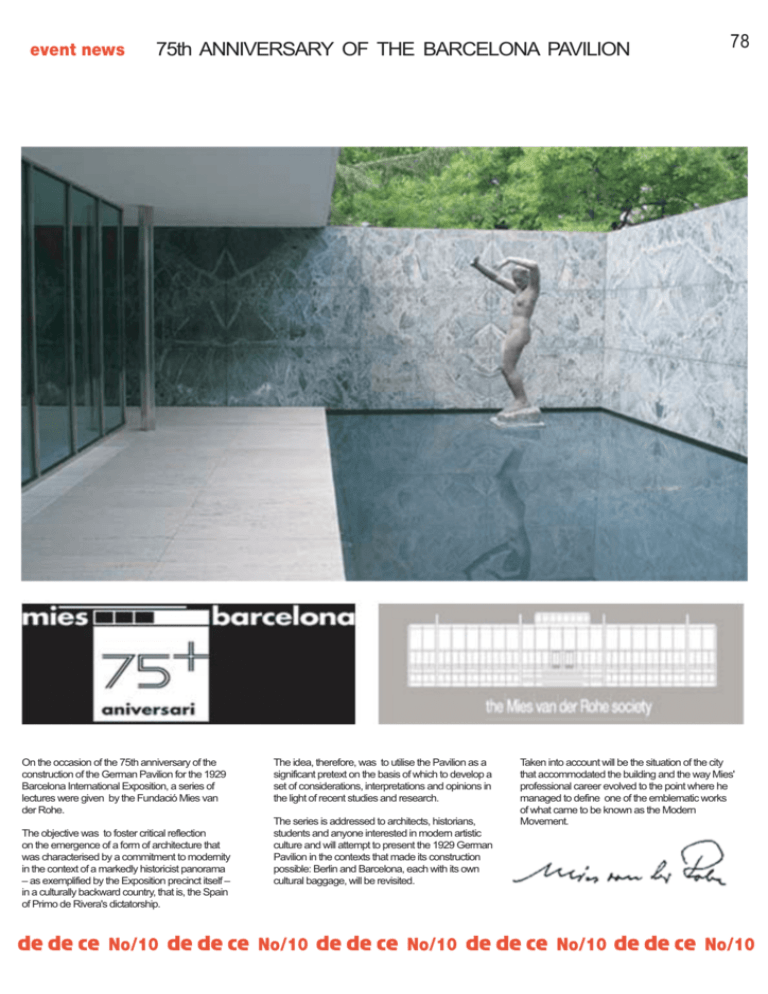
event news 75th ANNIVERSARY OF THE BARCELONA PAVILION On the occasion of the 75th anniversary of the construction of the German Pavilion for the 1929 Barcelona International Exposition, a series of lectures were given by the Fundació Mies van der Rohe. The objective was to foster critical reflection on the emergence of a form of architecture that was characterised by a commitment to modernity in the context of a markedly historicist panorama – as exemplified by the Exposition precinct itself – in a culturally backward country, that is, the Spain of Primo de Rivera's dictatorship. No/10 The idea, therefore, was to utilise the Pavilion as a significant pretext on the basis of which to develop a set of considerations, interpretations and opinions in the light of recent studies and research. The series is addressed to architects, historians, students and anyone interested in modern artistic culture and will attempt to present the 1929 German Pavilion in the contexts that made its construction possible: Berlin and Barcelona, each with its own cultural baggage, will be revisited. No/10 No/10 78 Taken into account will be the situation of the city that accommodated the building and the way Mies' professional career evolved to the point where he managed to define one of the emblematic works of what came to be known as the Modern Movement. No/10 No/10 event news 79 BARCELONA PAVILION The George Kobe sculpture was a last minute choice One of the classic designs of International Modernism, technically this building should be called the German Pavilion in Barcelona, since it was constructed as a temporary building for the International Exposition in Barcelona of 1929. Though temporary, it was still made of permanant materials--steel, glass, marble, and travertine. The Barcelona Pavilion was designed to represent Germany’s "openness, liberality, modernity and internationalism…we do not want anything but clarity, simplicity and honesty," stipulated the Commissar General of the Reich. A prominent member of the German architectural avant-garde, Ludwig Mies van der Rohe, was commissioned to design it. A year later he would be the Director of the Bauhaus School for art, crafts and architecture, and forty years after that he would be commemorated as one of the great architects of the twentieth century. Although the building was dismantled in 1930 it was rebuilt on the original site by a team of 3 architects in 1986. Mies also designed the chairs and stools which were expensive but austere in look: white leather strands were interweaved on thick-firm cushions and the x-shaped frame is in chromed steel. The chairs were designed to be used as thrones for the Spanish King and Queen when the German Ambassador received them. There was no other furniture or fixtures, apart from a deep red velvet curtain. "The site selected by Mies for the German Pavilion in Barcelona allowed for the transverse passage of visitors from a terrace-like avenue bordering the exhibition palaces to the other attractions. In addition, it afforded fine views of the exposition grounds and of the city of Barcelona. The building had no real program, as that term is understood and used by architects today. It was to be whatever Mies chose to make of it. The only function it had to accommodate was a reception for the King and Queen of Spain as they signed the "Golden Book" officially opening the exposition. According to Mies, the furniture designed and fabricated especially for the pavilion, the Barcelona chairs and stools, went unused during the opening ceremony. "To tell you the truth," he remarked, "nobody ever used them." It was not intended to exhibit the works of German manufacturers, but was rather supposed to make a bold statement about contemporary Germany. The building lasted six months before it was dismantled and the materials sold. Nonetheless, it remained an icon of the Modern Movement throughout the 20th century, The Pavilion received little attention during its brief lifetime. The late twenties were a time when Modernists were struggling to gain commissions and acceptance of their ideas . Nonetheless, the building soon became a totem for Mies' like-minded contemporaries. Less is More Freed from traditional design constraints (i.e. no-one had to live or work in the building, and the only 'exhibits' were a few chairs designed by Mies, he was able to construct a building which came to epitomise what Modern architecture should be clean, uncomplicated in appearance, with no apparent reference to past historical styles, and using modern technology to explore new ways of construction. The building still looks modern today, partly because many of the design features are still copied by 21st century architects. The glass appeared to be load bearing which made the thin concrete roof seem to float above the stone podium on which the whole structure is based. The roof is held in place by cruciform steel columns which are clad in chrome. The walls are marble and travertine. The open-plan nature of the Pavilion allowed Mies to experiment with space, creating an ambiguity about what is interior and what is exterior, and there is a tranquillity about the place despite its completely open-ended structure. The simple emptiness of the Pavilion was in itself a revolutionary feature. No/10 No/10 No/10 No/10 No/10 event news 80 BARCELONA PAVILION -- THE ONYX WALL According to Mies: "Right from the beginning I had a clear idea of what to do with that pavilion. But nothing was fixed yet, it was still a bit hazy. But then when I visited the showrooms of a marble firm at Hamburg, I said: "Tell me, haven't you got something else, something really beautiful?". I thought of that freestanding wall I had, and so they said: "Well, we have a big block of onyx. But that block is sold—to the North German Lloyd." They want to make big vases from it for the dining room in a new steamer. So I said: 'Listen, let me see it, ' and they at once shouted: 'No, no, no, that can't be done, for Heaven's sake you mustn't touch that marvellous piece." But I said: "Just give me a hammer, will you, and I'll show you how we used to do that at home." So reluctantly they brought a hammer, and they were curious whether I would want to chip away a corner. But no, I hit the block hard just once right in the middle, and off came a thin slab the size of my hand. 'Now go and polish it at once so that I can see it." And so we decided to use onyx. We fixed the quantities and brought the stone." No/10 No/10 No/10 No/10 No/10 event news 81 BARCELONA PAVILION Official party photo taken at the Opening of the German Pavilion at the Barcelona World Expo, 1929. Invitation to the official relaunching of the reconstructed Barcelona Pavilion, 1986 No/10 No/10 No/10 No/10 No/10 event news 82 BARCELONA PAVILION Postcard showing architecture at the World Expo in Barcelona, 1929 - highlighting just how radically progressive the German pavillon was. No/10 No/10 No/10 No/10 No/10 event news 83 NOTABLE COMMENTS CONCERNING THE PAVILION Despite the perfect vertical and horizontal lines, the building appears in no way hard or industrial, and yet it was new technology and methods of utilising concrete and steel made the whole thing possible. The two reflecting pools and Georg Kolbe's classical and curvy female statue combine with Mies' geometry to create a space which is amazingly calm and meditative; one in which Mies's famous dictum 'less is more' seems perfectly appropriate. Today architects and students flock to the Pavilion to admire Mies' achievement, and to see for themselves a building whose influence can be seen in every building which seeks to do away with stone walls and replace them with sheets of plate glass. Mies himself went on to perfect the corporate glass and steel skyscraper in the United States, using many of the techniques he applied so successfully at his Pavilion. And although the Pavilion is, in a sense, pointless, in 1929 it stood as a monument to what the Modernist architect could achieve. NOTABLE COMMENTS RE PAVILION "The covered portion of the pavilion, one story high, occupied roughly the north half of the podium. Beneath its flat roof ran the series of interwoven spaces that has, as much as anything else, won the Barcelona Pavilion its immense prestige. The roof rested on walls, or more properly wall planes, placed asymmetrically but always in parallels or perpendiculars, so that they appeared to slide past each other in a space through which the viewer could walk more or less endlessly, without ever being stopped within a cubical area. This open plan, with its intimation of an infinite freedom of movement, was at the same time qualified by two rows of equally spaced, cruciform columns that stood in martial formation amid the gliding walls. The columnar arrangement constituted Mies's first use of the grid as an ordering factor in his building, a prefiguration of the monumental regularity that marked the work of his American years." Franz Schulze No/10 "The Barcelona pavilion...was without practical purpose. No functional programme determined or even influenced its appearance. No part of its interior was taken up by exhibits: the building itself was the object on view and the 'exhibition' was an architectural space such as had never been seen. The building consisted of walls and columns arranged on a low travertine marble podium...it channeled space between separate vertical and horizontal planes. But this time the flow of space was held within clamp-like walls at each end of the podium." Martin Pawley, "In reality, the Barcelona Pavilion was a patch-up structure. Technically Mies was unable to erect the pavilion as a pure 'Dom-ino' structure; the eight cruciform columns alone could not support the roof and a number of extra columns had to be lodged in the double-skinned marble screens to help carry the load. But this makeshift structure did the job Mies asked of it and the plan remained inviolate. He pursued the idea in his model house at the Berlin Building Exhibition of 1931,..." Frank Russell, "Radical rationalist that he is, his designs are governed by a passion for beautiful architecture. He is one of the very few modern architects who has carried its theories beyond a barren functional formula into the plastically beautiful. Material and space disposition are the ingredients with which he gets his effect of elegant serenity. Evoking in his work a love for beautiful materials and textures he emphasizes this predilection." Helen Appleton Read. "For me working in Barcelona was a brilliant moment in my life." Mies van der Rohe. "Artistic expression is a manifestation of the unity of design and material.This once again underlines the necessity to incorporate works of sculpture (or painting) creatively into the interior setting from the outset. In the great epochs of cultural history this was done by architects as a matter of course and, no doubt, without conscious reflection." Mies van der Rohe. "I have tried to make an architecture for a technological society. I have wanted to keep everything reasonable and clear--to have an architecture that anybody can do." Mies van der Rohe No/10 No/10 "Architecture is an expression of how one protects himself against the outside world, and how one manages to conquer it. It always represents the expression of spiritual decision in space". Mies van der Rohe "There are real construction elements, from which a new richer architecture can be developed. They give us a measure of freedom that we no longer want to give up. Only now can we divide, open and join space with the landscape, in order to fulfil modern man's need for space. Simplicity of construction, clarity of tectonic means and purity of materials become the bearers of a new beauty". Mies van der Rohe No/10 No/10 event news FOUNDATION MIES VAN DER ROHE CELEBRATIONS 84 The Fundació Mies van der Rohe, along with the member institutions of its Board of Trustees, planned a series of activities to celebrate the 75th anniversary of the Pavilion. A series of cultural events are being held in different Mediterranean cities with the aim of promoting values such as peace, cohabitation, solidarity and sustainability, such as the Olympic Games in Athens, the European Cultural Capital of Genoa and the Forum Barcelona 2004. As a contribution to these initiatives, the theatre group La Fura dels Baus offered its ship, the Naumon, as a meeting point for the Fundació Mies van der Rohe at La Biennale di Venezia. The Naumon became the floating site for conferences, exhibitions, workshops and shows. On its itinerary through different Mediterranean ports such as Athens, Barcelona, Beirut, Istanbul, Marseilles and Venice, the Naumon will be transformed into a laboratory where the experiences of these cities may be analysed and compared. Above all, the intention is to meet a common objective in each of these cities: research on social housing and public space as two compatible systems that may be conceived in a unitary way and used as a tool for transformation in deteriorated urban settings. During the second half of the 20th century, the majority of European cities were subject to phenomena such as immigration and tourism that have resulted in conditions of violent clashes. Moreover, in many cities emergency situations such as wars and natural catastrophes still generate the relentless destruction of their recognisable urban fabrics, resulting in the sudden emergence of new opportunities for construction. During this period, almost all cities were forced to build new housing block developments on their outskirts that disregard the ideas of the Modern Movement concerning typologies and urbanism. The outcome is the rise of new ghettos characterised by deficient connections with the historical city centre, a lack of qualified public space, defective construction and a rigid, unimaginative typological approach to public housing design. No/10 No/10 No/10 No/10 No/10 event news 85 BARCELONA ® TRADEMARK PROTECTION GRANTED Knoll Announces Trademark Office Protection for its Mies van der Rohe Barcelona® Collection and Flat Bar Brno Chair From the hand-buffed frame to the individual leather squares carefully welted together, Mies intended each Barcelona® piece to honor traditional craftsmanship and meticulous attention to detail; October 22, 2004 Knoll, Inc., a leading designer and manufacturer of branded furniture and textiles, announced today that the United States Patent and Trademark Office has granted it registered trademark protection for five of its world-famous furniture designs created by Mies van der Rohe: the Barcelona ® Chair, the Barcelona ® Stool, the Barcelona ® Couch the Barcelona ® Table and the Flat Bar Brno Chair. The grant by this government agency recognizes the renown of these designs and gives Knoll government authority to pursue knock-offs of these registered designs. These knock-offs, whether manufactured domestically or imported, will be considered infringements of the Knoll registered trademarks and will subject the infringer to damages and product impoundment. Ludwig Mies van der Rohe, a world-famous architect and one of the most influential designers of the twentieth century, designed the German pavilion for the 1929 Barcelona International Exhibition. The result was one of the master's best-known architectural designs. "God is in the details," remains his most characteristic statement of philosophy, and one this collection reflects. Director of the Bauhaus school of design from 1930 to 1933, Mies moved to the United States in 1937. In 1948, he and Florence Knoll collaborated to manufacture the Barcelona collection, comprised of the chair, stool and table, for the first time in the United States. Later, Knoll added the Flat Bar Brno Chair and the Barcelona® Couch to the collection; both were made to Mies's specifications. To receive the legal recognition of being a registered trademark, a furniture design must be shown to the Trademark Office as having acquired an association and recognizable distinctiveness in connection with its manufacturer. Knoll demonstrated to the government agency that the Barcelona® collection has been sold in significant volume since the 1950s, had been continuously marketed and promoted as acclaimed Mies van der Rohe designs, and had been exhibited in design museums around the world as a work of art. The Trademark Office reviewed and accepted Knoll's claims, and promptly issued trademark registrations for these items. The pure composition of the Barcelona® collection has since come to epitomize Modern architecture. No/10 The issuance of these trademark registrations signals the beginning of the Company's effort to ensure that when architects, furniture retailers or the public purchase a Mies van der Rohe design, they will be purchasing the genuine article, following Mies van der Rohe's historic design specifications. No/10 No/10 Andrew Cogan, CEO of Knoll, stated, "We are committed to preserving the integrity of these landmark designs, and will continue to manufacture these products according to the designer's original specifications. "We are especially pleased that the United States Patent & Trademark Office has recognized the need for trademark protection for the Barcelona collection and the Flat Bar Brno Chair, and we will be working with U.S. Customs to stop unauthorized imports from reaching this country," "Some of Mies's well-known architectural works include the Seagram Building in New York City; the Lakeshore Drive Apartments in Chicago, Illinois; and the Tugendhat House, in Brno, Czech Republic. Founded in 1938, Knoll pioneered the principles of modern design in the workplace, from space planning to furniture to accessories. No/10 No/10 event news 86 "GOD IS IN THE DETAILS" -- MIES The modern city, with its towers of glass and steel, can be at least in part attributed to the influence of architect Mies van der Rohe. Equally significant, if smaller in scale, is Mies' daring design of furniture, pieces that exhibit an unerring sense of proportion, as well as minimalist forms and exquisitely refined details. In fact, his chairs have been called architecture in miniature exercises in structure and materials that achieve an extraordinary visual harmony as autonomous pieces or in relation to the interiors for which they were originally designed. In the mid-1920's, he began to design furniture, pieces that he conceived and created for particular interiors. In 1927, Mies met Lilly Reich, a Bauhaus alumnus who collaborated with Mies on his first versions of a cantilevered chair with a tubular steel frame. No/10 The cantilevered chair had a curved frame that exploited the aesthetic, as well as the structural possibilities of this material. Their experiments culminated in the virtuoso Brno chair designed between 1929 and 1930 with a chromed flat steel frame. Two years later, Mies and Lilly Reich designed what is perhaps his most famous creation the Barcelona chair and footstool. Created for the German Pavilion at the Barcelona International Exhibition, the Pavilion chair was intended as a modern throne; a thick cushion upholstered in luxurious leather and set upon a curved metal frame in the shape of an X inspired by classical furniture. His inspiration for the Barcelona chair was the Form Fan Egyptian folding chair, long thought to be a symbol of power, and a folding stool from Roman times. No/10 No/10 Perfectly proportioned and finished, the simple chair exuded an air of elegance and authority. In 1938, Mies emigrated from Europe and moved to Chicago. The rest of his career was devoted to promoting the Modernist style of architecture in the U.S., resulting in rigorously modern buildings such as the Farnsworth House and the Seagram Building, designed with Philip Johnson. The Bauhaus, started by Walter Gropius in 1919 to be a "laboratory for mass consumption", embraced the machine aesthetic which focused on design and material choices that were appropriate for mass production. Designers were led to experiment with materials and carefully scrutinized their designs for manufacturability and efficiency, often more so than for aesthetics. In the period between World War I and World War II, the machine had a powerful impact on culture and design in America and Europe. No/10 No/10 event news 87 "GOD IS IN THE DETAILS" -- BARCELONA SERIES Early model prototype of the Barcelona footstool. Engineering drawings for the famous Barcelona footstool "X:" W.I.P. Sketches by Mies in his exploration for a coffee table design to suit the Barcelona chair and stool. Mies' daring design of furniture, exhibit an unerring sense of proportion, as well as minimalist forms and exquisitely refined details. In fact, his chairs have been called architecture in miniature exercises in structure and materials that achieve an extraordinary visual harmony. Barcelona collection No/10 No/10 No/10 No/10 No/10 event news 88 "GOD IS IN THE DETAILS" -- OTHER CHAIRS BY MIES BRNO chair - flat bar - 1930 MR Series - 1927 BRNO chair - round tubular Artists and designers struggled to understand and make sense of the new machine-driven world, and experimented with the direction it might give to their work. This movement towards modern design depended heavily on new materials and manufacturing processes as well as a new consideration for function. For Breuer, standardized steel tubing was light, manageable and durable. This material was to become a significant emblem of the Modern Movement. This famous chair is closely related to the cantilevered chair by Ludwig Meis van der Rohe at the Bauhaus at the same period. One of these new materials was tubular-steel. The Wassily armchair by Marcel Breuer was one of the first examples of modular tube-steel furniture and has become inextricably associated with the Bauhaus. A pioneer in the Modern Movement and among the first to exploit the possibilities of tubular steel for mass-produced furniture, Breuer, a student and later a teacher at the Bauhaus carpentry workshop, sought a material that expressed its modern industrial origins in a way that wood, also a modern material, could not. No/10 Why was this tube construction technique such a dramatic advancement in furniture design and manufacture? First of all, it made possible a far more efficient method of joining components. The parts could be welded together for clean, strong joints, with no bulky structures. Second, the tubes could be finished with chrome No/10 No/10 Finally, the results of this system were lighter in appearance and far stronger than wooden members of similar size. The nature of wood required that joints be of substantial size to give necessary strength. This is a good example of how technological advances affect the way products are made and how they look. Ironically, chair designs such as these, which appear very much to be machinemade, were in fact very labor-intensive to produce and, therefore costly to manufacture—an aspect that ran counter to the Bauhaus philosophy. It was realized that the true mass-production of Modern furniture would only be possible if a form of mechanized standardization was adopted. However, it was not until after World War II that it became economically and technically feasible to achieve this on a wide scale No/10 No/10 event news "MR SERIES" -- CONCEPT DESIGN SKETCHES 89 MR TABLE 1927 In 1927, the design and patent for his tubular steel cantilevered chair brought Mies into the international spotlight. The chair was a simple cantilevered curved structure with a woven cane seat, made in various versions with and without armrests. The character of the chair, was that of a formal, refined comfort. The seat and back would give slightly, under the user's weight, but the outward appearance replaced the cosy qualities of a large upholstered armchair - with a smaller and more streamlined chair. No/10 No/10 No/10 No/10 No/10
